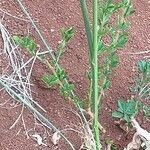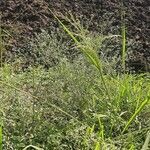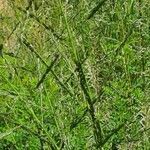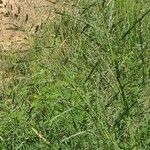Caespitose perennial arising from a short oblique rhizome; culms up to 170 cm tall, 2–3 mm in diameter at the base (rarely more), erect, usually unbranched, the leaves mostly basal, but the taller culms usually more leafy; basal leaf sheaths chartaceous, glabrous or ciliate to lanate along the margins, terete to strongly compressed and keeled, persistent; leaf laminas 10–30(60) cm × 2.5–7.5(14) mm, flat, folded or involute, glabrous, the midnerve forming a white streak on the upper surface, scaberulous or tuberculate-pilose on the surfaces, the margins thinly cartilaginous (and often reddish in colour), smooth or tuberculate-ciliate, tapering to a long filiform flexuous apex.
Densely tufted perennial, 0.24-1.60 m high; rhizome oblique. Leaf blade up to 300 x 2-4 mm wide; ligule a fringed membrane or a fringe of hairs. Inflorescence a fairly dense, open panicle; branches many, not whorled nor spreading > 60 degrees. Spikelets 1.4-2.2 mm long, laterally compressed, awnless, glabrous, disarticulating above glumes; glumes 1-nerved; lower glume 1/4-3/4 as long as spikelet; upper glume ± 2/3 as long as spikelet. Floret 1; lemma similar in texture to glumes, membranous, often shining, 1-3-nerved. Flowering time Dec.-May.
Densely tufted perennial 240-1600 mm high; rhizome characteristically oblique; lower leaf sheaths herbaceous. Leaf blade to 300 x 2-4 mm. Inflorescence open, branches numerous, not whorled, not spreading more than 60 degrees. Spikelet 1.4-2.2 mm long; glumes unequal; lower glume 1/4-3/4 as long as spikelet, obtuse to subacute, nerveless; upper glume ± 4/5 to as long as spikelet, apex acute; lemma almost as long as spikelet, narrowly ovate; anther 0.8-1.5 mm long.
Spikelets 1.4–2.1(2.4) mm long, dark green; inferior glume (1/3)2/5–2/3 the length of the spikelet, narrowly oblong to lanceolate, hyaline, nerveless, glabrous or minutely asperulous, obtuse to subacute at the apex; superior glume 4/5 as long to as long as the spikelet, narrowly ovate, 1-nerved, hyaline, glabrous or minutely asperulous, acute at the apex; lemma as long as the spikelet or almost so, narrowly ovate; anthers 3, 0.9–1.2 mm long.
Perennial, densely tufted and rhizomatous (rhizome characteristically oblique), up to 1.6 m high. Leaf blades up to 300 mm long, 2-4 mm wide. Spikelets 1.4-2.2 mm long. Panicle fairly dense, open, branches numerous, not whorled and not spreading more than 60°; lower glume a quarter to three-quarters the spikelet length; upper glume ± two-thirds the spikelet length.
Panicle 15–65 cm long, linear to lanceolate, the branches not in whorls (rarely subverticillate), 3–12 cm long, smooth or scaberulous, eglandular, the spikelets either on short tertiary branchlets on spreading secondary branchlets, or secund along the secondary branchlets, in either case the primary branches bare of spikelets or branchlets at the base.
Perennial; up to 1.6 m high; densely tufted and rhizome characteristically oblique. Leaf blades up to 300 x 2-4 mm. Flowers: panicle fairly dense; open; branches many; not whorled and not spreading > 60°; spikelets 1.4-2.2 mm long; lower glume 1/4-3/4 spikelet length; upper glume ± 2/3 spikelet length.
Perennial, up to 1.6 m tall. Leaves linear; ligule a fringe of hairs. Inflorescence an open panicle, branches spread at ± 60 degrees, lowest branches not whorled. Spikelets 1.4-2.2 mm long, awnless, glabrous, 1-flowered; glumes unequal; upper 2/3 as long as spikelet.
A herb. It is a grass that forms tussocks. It is erect and keep growing from year to year but loses its leaves. It has underground stems or rhizomes. It can grow 1.7 m high. The leaves can be 30 cm long and 2-4 mm wide.
Like S. africanus but to 1.6 m, spikelets 1.4-2.2 mm long, upper glume two-thirds as long, panicle open with branches spreading at ± 60o.
Grain c. 0.6 mm long, obovate, truncate, tetragonal in section.




